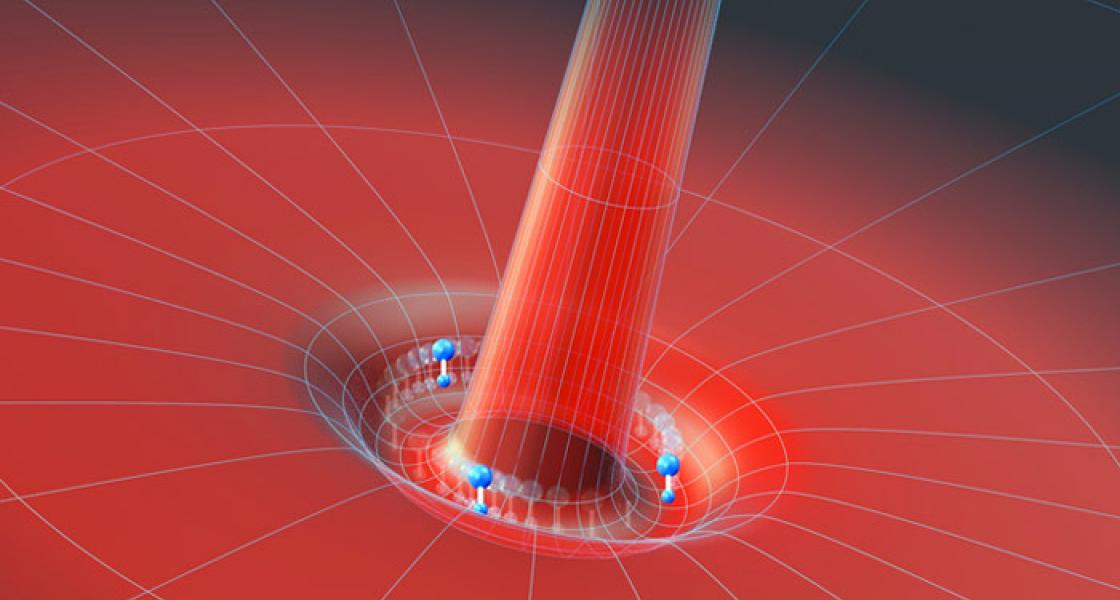There’s exciting news in the field of Efimov physics!
It’s been more than 40 years since Russian theoretical physicist Vitaly Efimov predicted a strange form of matter called the Efimov state in 1970. In these strange states, three atoms can stick together in an infinite number of new quantum states, even though any two of the atoms can’t even form a molecule. For a long time, scientists were skeptical about Efimov’s prediction. However, since the 1990s, Fellow Chris Greene’s group (with J. P. Burke, JR. and Brett Esry) have expanded the theory of Efimov physics and predicted the experimental conditions under which Efimov states can be observed. In 2006, these strange states were observed experimentally for the first time.
Three-atom Efimov molecules (trimers) can form in Bose-Einstein condensates (BECs) or other ultracold gases. The Efimov trimers form because of a kind of memory “ghost” created through the attraction felt by the atoms only when they are stacked immediately on top of each other in an ultracold gas. This eerie attraction can lead to the formation of an endless sea of three bound quantum states, even when individual atoms are far apart.
Now, the Greene group has shown that dipolar Efimov trimers can also form in an ultracold system. The dipolar Efimov states are even more peculiar than “ordinary” Efimov molecules. The strangest thing is that they exist at all. Theorists including senior research associate José D’Incao and Fellow Chris Greene once thought the Efimov effect would not occur with atoms and molecules in a strong electric field. However, the JILA researchers have just proved that they were mistaken.
Even though (1) the atoms in a dipolar Efimov trimer are normally very far apart and extremely weakly bound, and even though (2) an electric field exerts a twist on the dipolar trimers to align with the field, the Efimov effect persists in dipolar systems. In fact, in a dipole system, the stronger the electric field, the longer the Efimov molecules live! Dipolar Efimov states can survive long enough inside a dipolar gas that experimental physicists should be able to create and manipulate them in the laboratory, according to the JILA theorists.
This kind of survival is stunning when you consider that Efimov physics in an ultracold dipolar BEC is constrained by an electric field. However, the major constraint is not if the molecules can form. Rather, it is that Efimov trimers can only form inside a well-defined band of energy that looks a little like the hatband on a Mexican sombrero.
Chalk one up for the laws of attraction — and the utter weirdness of the quantum world. “The quantum world we study looks crazy, but it’s actually real,” says research associate Yujun Wang, who worked with D’Incao and Greene to probe the nature of the Efimov effect in an ultracold dipolar system. The researchers have predicted where in the system the Efimov states form. Once the molecules form, they are easy to see because they exhibit a clear mathematical signature. And, as soon as the first Efimov molecule appears in the system, the researchers are able to predict the energies of its sister molecules that form in limitless quantities in the same energy band. The researchers have also found a series of magic values for the electric field that led to the formation of an infinite number of Efimov states.
Not surprisingly, dipole interactions prevent the atoms in an Efimov trimer from getting too close together. And, if all the dipoles in a trimer do come close together, it is difficult to explain the physics of what happens. However, once the dipoles are far apart, the physics of their interactions becomes more universal and easier to describe mathematically. This discovery is a key insight for future ultracold molecule experiments.
It turns out that Efimov molecules can be destructive when they are unstable. Experimental physicists don’t want unstable Efimov molecules knocking atoms out of an optical trap and destroying an ultracold system. Because Efimov molecules are more stable in an electric field, they’ll also be much easier to study there.
Wang, D’Incao, and Greene hope that experimentalists will soon take up the challenge of studying Efimov states in ultracold gases in the presence of electric fields. In the meantime, though, the JILA theorists are now exploring the weird quantum states of ultracold dipolar fermions. Fermions cannot occupy the same quantum state, unlike the neighborly bosons, which happily form BECs at ultracold temperatures. So it isn’t clear what will happen to dipolar fermions under conditions that would lead to the formation of Efimov molecules made of bosons. The Greene group hopes to find out soon.




